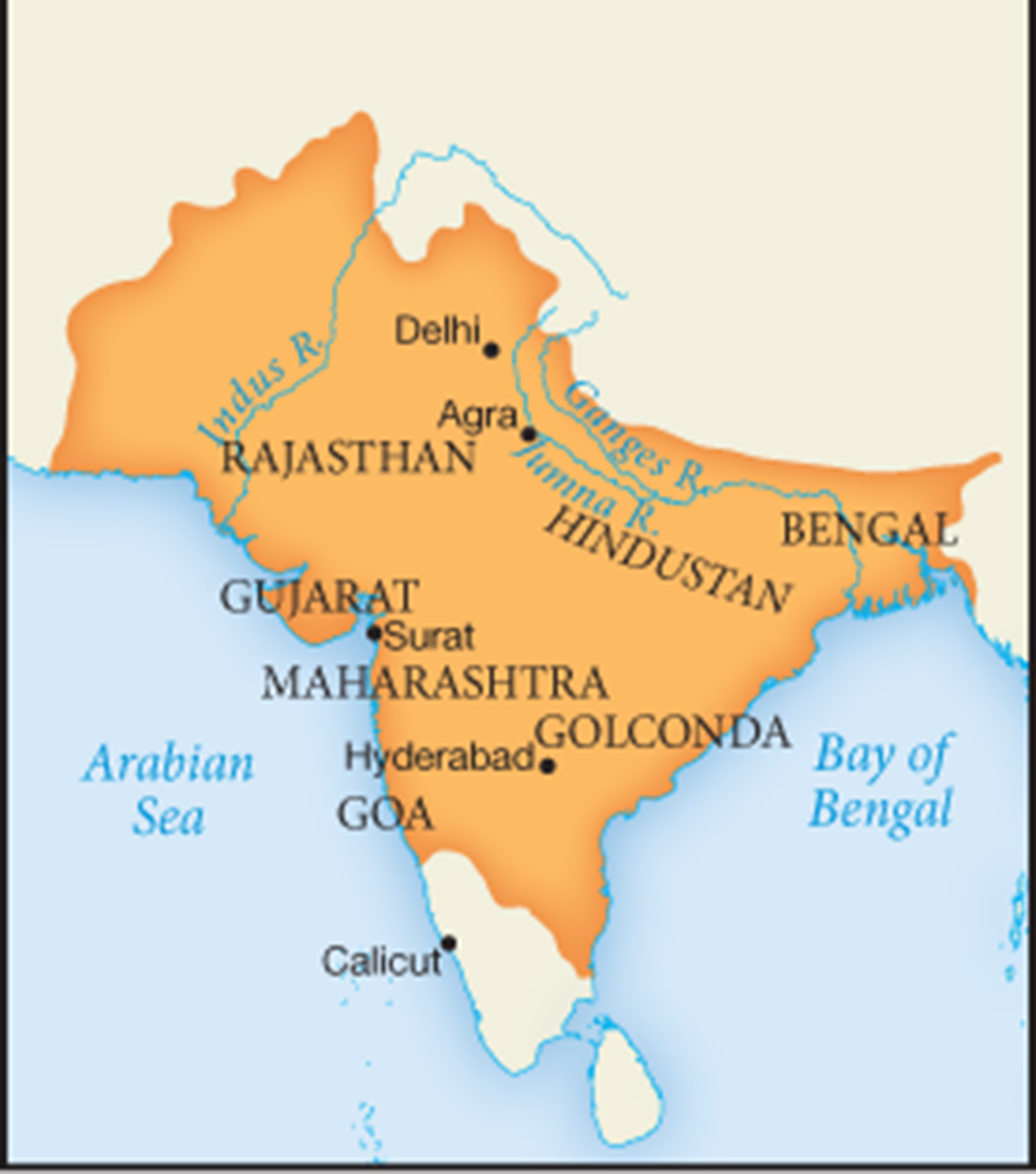Muslims and Hindus in the Mughal Empire
If the creation of a Chinese imperial state in the early modern era provoked a final clash of nomadic pastoralists and settled farmers, India’s Mughal Empire hosted a different kind of encounter—a further phase in the long interaction of Islamic and Hindu cultures in South Asia. That empire was the product of Central Asian warriors, who were Muslims in religion and Turkic in culture and who claimed descent from Chinggis Khan and Timur (see Chapters 11 and 12). Their brutal conquests in the sixteenth century provided India with a rare period of relative political unity (1526–1707), as Mughal emperors exercised a fragile control over a diverse and fragmented subcontinent, which had long been divided into a bewildering variety of small states, principalities, tribes, castes, sects, and ethno-linguistic groups.
How did Mughal attitudes and policies toward Hindus change from the time of Akbar to that of Aurangzeb?
The central division within Mughal India was religious. The ruling dynasty and perhaps 20 percent of the population were Muslims; most of the rest practiced some form of Hinduism. Mughal India’s most famous emperor, Akbar (r. 1556–1605), clearly recognized this fundamental reality and acted deliberately to accommodate the Hindu majority. After conquering the warrior-based and Hindu Rajputs of northwestern India, Akbar married several of their princesses but did not require them to convert to Islam. He incorporated a substantial number of Hindus into the political-military elite of the empire and supported the building of Hindu temples as well as mosques, palaces, and forts. (See Working with Evidence, Source 13.1.) But Akbar acted to soften some Hindu restrictions on women, encouraging the remarriage of widows, discouraging child marriages and sati (the practice in which a widow followed her husband to death by throwing herself on his funeral pyre), and persuading merchants to set aside special market days for women so as to moderate their seclusion in the home. Nur Jahan, the twentieth and favorite wife of Emperor Jahangir (r. 1605–1627), was widely regarded as the power behind the throne of her alcohol- and opium-addicted husband, giving audiences to visiting dignitaries, consulting with ministers, and even having a coin issued in her name.

The Mughal Empire
In directly religious matters, Akbar imposed a policy of toleration, deliberately restraining the more militantly Islamic ulama (religious scholars) and removing the special tax (jizya) on non-Muslims. He constructed a special House of Worship where he presided over intellectual discussion with representatives of many religions—Muslim, Hindu, Christian, Buddhist, Jewish, Jain, and Zoroastrian. His son Jahangir wrote proudly of his father: “He associated with the good of every race and creed and persuasion…. The professors of various faiths had room in the broad expanse of his incomparable sway.”28 Akbar went so far as to create his own state cult, a religious faith aimed at the Mughal elite, drawing on Islam, Hinduism, and Zoroastrianism and emphasizing loyalty to the emperor himself. The overall style of the Mughal Empire was that of a blended elite culture in which both Hindus and various Muslim groups could feel comfortable. Thus Persian artists and writers were welcomed into the empire, and the Hindu epic Ramayana was translated into Persian, while various Persian classics appeared in Hindi and Sanskrit. In short, Akbar and his immediate successors downplayed a distinctly Islamic identity for the Mughal Empire in favor of a cosmopolitan and hybrid Indian-Persian-Turkic culture.
Such policies fostered sharp opposition among some Muslims. The philosopher Shaykh Ahmad Sirhindi (1564–1624), claiming to be a “renewer” of authentic Islam in his time, strongly objected to this cultural synthesis. The worship of saints, the sacrifice of animals, and support for Hindu religious festivals all represented impure intrusions of Sufi Islam or Hinduism that needed to be rooted out. In Sirhindi’s view, it was primarily women who had introduced these deviations: “Because of their utter stupidity women pray to stones and idols and ask for their help. This practice is common, especially when small pox strikes, and there is hardly a woman who is not involved in this polytheistic practice. Women participate in the holidays of Hindus and Jews. They celebrate Diwali [a major Hindu festival] and send their sisters and daughters presents similar to those exchanged by the infidels.”29 It was therefore the duty of Muslim rulers to impose the sharia (Islamic law), to enforce the jizya, and to remove non-Muslims from high office.
This strain of Muslim thinking found a champion in the emperor Aurangzeb (ow-rang-ZEHB) (r. 1658–1707), who reversed Akbar’s policy of accommodation and sought to impose Islamic supremacy. While Akbar had discouraged the Hindu practice of sati, Aurangzeb forbade it outright. Music and dance were now banned at court, and previously tolerated vices such as gambling, drinking, prostitution, and narcotics were actively suppressed. Dancing girls were ordered to get married or leave the empire altogether. Some Hindu temples were destroyed, and the jizya was reimposed. “Censors of public morals,” posted to large cities, enforced Islamic law.
Aurangzeb’s religious policies, combined with intolerable demands for taxes to support his many wars of expansion, antagonized Hindus and prompted various movements of opposition to the Mughals. “Your subjects are trampled underfoot,” wrote one anonymous protester. “Every province of your empire is impoverished…. God is the God of all mankind, not the God of Mussalmans [Muslims] alone.”30 These opposition movements, some of them self-consciously Hindu, fatally fractured the Mughal Empire, especially after Aurangzeb’s death in 1707, and opened the way for a British takeover in the second half of the eighteenth century.
Thus the Mughal Empire was the site of a highly significant encounter between two of the world’s great religious traditions. It began with an experiment in multicultural empire building and ended in growing antagonism between Hindus and Muslims. In the centuries that followed, both elements of the Mughal experience would be repeated.
